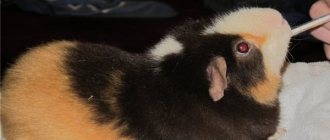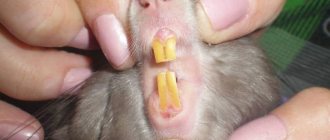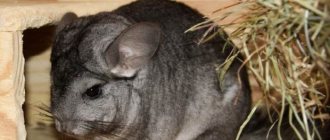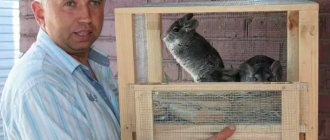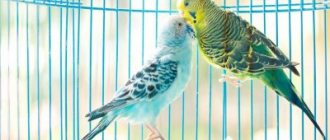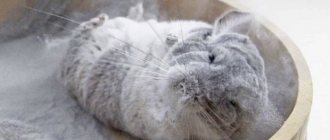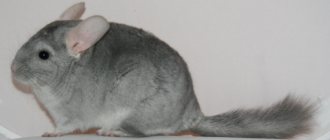In the wild, chinchillas live in mountainous areas, so they are well adapted to cool climates. However, colds can still occur in chinchillas at home. If the animal begins to sneeze, cough and has watery eyes or a runny nose, it is necessary to take it to the veterinarian for timely assistance. The doctor will understand the causes of the ailment and select the appropriate treatment.
Cough, watery eyes, runny nose and sneezing in chinchillas
A cough, runny nose and watery eyes are not always caused by a cold. Sometimes similar symptoms are provoked by other reasons, which include:
- allergic reaction. Allergies can be triggered by indoor plants, food, toilet and bath filler. If an animal truly has an allergic reaction, in addition to the main symptoms, it will experience swelling, itching, inflammatory processes on the skin, hair loss and restlessness. In this case, antihistamines are used as therapy, and also completely eliminate the effect of the allergen on the animal;
- entry of foreign bodies into the nasopharynx. Small particles of hay, sawdust or dust that get into the nose or throat cause chinchillas to continuously sneeze. If this happens, the rodent should be taken to a doctor and the object that irritates the mucous membranes should be removed. You cannot remove a foreign body yourself. This should only be done by a specialist;
- stressful situation. They are caused by improper handling of the animal or a sudden change in environment. When stressed, the animal begins to sneeze, squeak, tremble and freeze;
- colds. A cold in chinchillas causes fever, lethargy, coughing, watery eyes and a runny nose.
A runny nose in chinchillas manifests itself in mucous discharge from the sinuses, accumulation of mucus in the corners of the eyes, rapid breathing and lethargy. It can be caused by both a cold and allergies to dust, food, and filler. You can eliminate a runny nose by removing potential allergens, or by curing a cold if it was caused by it.
Prevention
Chinchillas are naturally healthy. They are not predisposed to hereditary diseases, and also do not get sick if the established conditions of detention are observed. However, if your pet's health worsens, serious problems can arise. The fact is that veterinarians specializing in the treatment of chinchillas are not available in every city. Then the treatment may take a long time. Therefore, it is better to adhere to some preventive measures to protect the health of the furry:
- Protect your chinchilla from hypothermia . To do this, you should not leave the cage in drafts, or bathe your pet in water. Once wet, a chinchilla's coat becomes very heavy and does not dry well. As a result, the animal can catch a cold even in summer.
- Choose a hypoallergenic filler . Safe options for chinchillas are sawdust or corn pellets. The latter are more expensive, but they absorb moisture and foreign odors much more reliably. Also, the corn filler does not contain small fractions and dust that can get into the fluffy’s nose.
- Buy quality food . You cannot feed your chinchilla the first thing you come across that is intended for feeding rodents. To avoid allergic reactions, you need to buy specialized food specifically for feeding chinchillas.
- Protect your pet from stressful situations . Chinchillas are very shy and get nervous about anything. Therefore, in the room with the cage there should always be a calm environment - the absence of noise, strangers, cats, dogs and other irritants.
- Remove the bathing suit from the cage immediately after taking hygiene procedures . This will help reduce the risk of volcanic dust or sand getting into your pet's nostrils.
Also, as a preventive measure against colds, you can add specialized vitamin complexes to your pet’s feeder. Preference should be given to supplements rich in vitamin C. They strengthen the immune system and improve metabolism.
Cough in rodents
Coughing in rodents can also be caused by various causes. They are presented:
- allergic reaction;
- heart failure. In addition to coughing, it is accompanied by wheezing and shortness of breath;
- tracheitis, pneumonia, bronchitis;
- foreign body in the larynx. The animal gags and attempts to cough up. In this case, you need to try to remove the stuck object yourself by turning the chinchilla upside down or take it to a doctor.
"Important! If suspicious symptoms appear, the owner needs to understand its causes, and for a more thorough diagnosis, it is better to show the rodent to a veterinarian.”
Poor quality filler
Why does a chinchilla sneeze? This may be a symptom that you are using the wrong filler in her cage, indoor plants near the cage or food are causing an allergic reaction. What to do in such a situation? Remove the irritant.
If the cause of the ailment is the filler, then you just need to replace it. Choose a filler from environmentally friendly materials, as these animals are very sensitive and can react to any irritant. Wood pellets and sawdust are excellent choices. You may also need to take antihistamines.
Colds in chinchillas
Despite the fact that rodents come from the Andes and have good immunity, prolonged exposure to drafts or improper living conditions often cause colds. Low temperature, humid air and infection are also very dangerous for animals.
How is a cold diagnosed in chinchillas? With this disease, the animal appears:
- cough and sneezing;
- rapid breathing;
- elevated temperature;
- runny nose and mucous discharge from the eyes;
- lethargy and drowsiness.
If these symptoms appear, the owner of the rodent should take the chinchilla to the veterinarian.
How to help a chinchilla with a cold?
Since, unlike other animals, colds in chinchillas, in principle, like other diseases, progress much faster, if dangerous symptoms appear, you should immediately contact a veterinarian.
To prevent a sick rodent from infecting other relatives, it should be placed in a separate cage, covered with a cloth for insulation. During a cold, the animal needs warmth. In addition, the owner of a sick rodent must ensure that the humidity in the room with the cage does not exceed 50%.
Depending on the condition of the chinchilla, the doctor prescribes antibacterial or anti-inflammatory therapy. Often animals are given chamomile or rosehip infusions instead of water. To wipe the eyes, use strong tea or a solution of 2% boric acid. We should not forget about a nutritious diet, which should contain a large amount of foods with vitamin C.
"Important information! If a chinchilla’s temperature rises to 38 degrees, it must be brought down immediately, as its further increase can be fatal.”
STROKE
Not the most common disease in chinchillas, but very dangerous, so I put it in first place. A stroke is a condition in which cerebral circulation is disrupted for several minutes or hours. At this moment, tissue death, rupture or blockage of brain vessels occurs.
Symptoms of stroke in chinchillas:
- Convulsions
- Loss of coordination
- Rvorta
- Rolls over or lies on its side
- Large amount of saliva
- Can't smell
- End paralysis (legs have failed, etc.)
If these symptoms occur, you should immediately contact a veterinarian. The minutes count; if you don’t help in time, the chinchilla will die. If your pet is dear to you, then do not try to save money on the veterinarian and try to cure it yourself.
Causes of Stroke in Chinchillas:
- Severe stress
- Severe head or spine injury
- Strong departure
- Sudden change in room temperature
- Severe vitamin B deficiency
- Sudden fear from external sources, such as sounds
- Improper care and feeding for a long time
- Delayed or improper treatment of other diseases
Other causes of cold symptoms
Not only colds in chinchillas provoke sneezing, watery eyes and a runny nose. Sometimes things can be much more serious.
Respiratory system diseases
If a chinchilla's cold is neglected or left untreated, it can lead to complications in the respiratory system. These include:
- pneumonia;
- bronchitis;
- pneumonia;
- tracheitis.
They are often caused by a secondary streptococcal or staphylococcal infection. Diseases of the respiratory system pose a serious danger to both young and adult individuals. If treatment is not done in a timely manner, there is a risk of death, so you should consult a doctor promptly and begin therapy. To treat such ailments, antibiotics are used, which are given in tablets or injected intramuscularly.
Symptoms of bronchopneumonia are:
- frequent cough;
- wheezing and difficulty breathing;
- high temperature;
- apathy.
For this disease, in addition to antibiotics, expectorants, food containing vitamin C and keeping the animal warm are prescribed.
Pneumonia usually develops in newborns born in the summer or autumn. The disease is provoked by a secondary infection, and the symptoms are similar to bronchopneumonia. Antibiotics, probiotics and a vitamin complex are prescribed as therapy to help support the immune system.
Under the wrong conditions, chinchillas can develop hyperthermic changes in the lungs, leading to overflow of the pulmonary vessels with blood. In this case, the rodent experiences suffocation, shortness of breath, rapid pulse, hoarse cough and foamy nasal discharge mixed with blood.
Since hyperemia is often caused by overheating, to eliminate it it is necessary to place the rodent in an optimal environment, and only then begin to eliminate the symptoms. If the chinchilla is overheated, it should be doused with cool water, given some heart drops and a diuretic. And if complications arise, antibiotics will need to be administered, but first the animal must be shown to a doctor to confirm the diagnosis.
Foreign body in the nose
An animal can also sneeze if a foreign body gets into its nose. When eating, particles of food or hay may well enter the nasopharynx, which will cause a reflex sneezing.
If the animal does not stop sneezing and behaves restlessly, it is necessary to immediately show it to a specialist to provide first aid in such a situation. You should not help your animal remove a foreign object on your own.
Stress in chinchillas
Stress, like colds, causes sneezing and watery eyes in chinchillas. In addition, after experiencing stress, the animal may experience trembling, numbness, anxiety and squeaking.
A stressful situation can be triggered by:
- a sharp change in the usual environment;
- transportation to a new place of residence or to a veterinarian;
- injuries;
- contacts with other animals;
- mistreatment of animals by humans;
- excessive attention to the chinchilla of strangers.
Before calming an agitated animal, it is necessary to find out the cause of the stress. After it is eliminated, you can begin to distract the frightened animal. You need to offer him his favorite food or play with him to bring his condition back to normal. If the chinchilla becomes even more irritable, you just need to leave it alone, covering the cage with a dark cloth. You can also offer the animal fresh mint leaves, which are completely safe for chinchillas and are an effective sedative.
Sounds and their meaning
What sounds does a chinchilla make? Everything pronounced by a pet is usually divided into two large groups: main and auxiliary. Each animal is individual. Among them, most are talkative, but there are also silent individuals or even grumpy ones.
What chinchillas say is conventionally divided into several categories.
Sounds of communication and communication
Typically, such communication signals are made by the cubs if they are trying to find their mother or are hungry. This is an insistent sound that is often repeated, usually similar to a child's squeak. If the female is near the baby and the baby is full, then it becomes like cooing pigeons.
Below are examples of sounds, click on the "start" button to listen. https://xvostus.com/wp-content/uploads/2018/01/1.mp3
Signs of anxiety, anger and defensiveness
At this time, the female becomes angry and makes a sound similar to a grinding sound.
This is how she attracts the attention of the kids and encourages them to remain calm.
Similar sounds are made by the female with the onset of estrus, when the male bothers her with his worries and, nervous, the female shows her dissatisfaction to her partner. During this process, she sprays a stream of urine at the male, rising on her hind legs.
Warning of danger, animals make sounds similar to the intermittent, loud barking of a dog. This is how the animal can react to a new environment, strong impacts, even strong aromas. Everything alarming and unusually new causes a reaction in chinchillas to notify everyone about the upcoming threat.
Mating Sounds
During the female's heat, the partner begins to make smooth sounds, but does it abruptly, thereby calling the partner to mate
At the same time, the male clears the floor under him and tries to attract the female’s attention by wagging his tail. After the mating process, the male makes unusual sounds for several minutes, similar to wheezing or hiccups
Signs of chewing
Many chinchillas make strange noises while eating, but don't be alarmed. This is how animals express their pleasure from eating food. Most often these sounds are similar to duck quacks.
Baby chinchillas
Before feeding babies, you can observe a whole ritual
The female responds with a soothing, caring grunt, licking the baby's ears. Having received the mother's approval, the cub crawls to her tummy and looks for a nipple with milk.
The female cleans its fur, licks it, and accustoms it to cleanliness. The mother also stimulates the baby’s genitals to “trigger” the mechanisms of bowel movements in the body. At the same time, the mother grunts carefully, and the animal squeaks happily. Watching chinchilla babies, you can see some similarities in behavior with human babies.
Watch the video to see what sounds baby chinchillas make.
Can a person infect a chinchilla with a cold?
No matter how surprising it may seem, chinchillas are very susceptible to many viruses that also affect people. Therefore, during the peak of a flu epidemic, you should thoroughly wash your hands and change into home clothes before contacting your pet. In addition, it is necessary to ventilate the room with the rodent more often and do wet cleaning there.
If the owner of the animal is sick with ARVI, until complete recovery he should minimize contact with the rodent, and when feeding it and cleaning the cage, he should wear a mask and gloves.
Following these simple rules will allow you to avoid such an unpleasant disease as a cold in chinchillas.
Hair ring
This problem often occurs in a young male, or in the father of a family. The ring can be formed from the fur of an injured male or his female, during violent mating behavior, or due to poor male hygiene.
Eliminating this problem is quite a simple and very important task, since an unretracted hair ring can cause the death of a male, since it can crush the genital organ and block the flow of urine. If the owner of the animal has discovered a thickening on his penis, and the genital organ itself has turned blue, this is the ring. You can remove it with simple nail scissors; the area of compression is lubricated with Vaseline.
Slobber
Drool is a dental disease.
Chinchillas have two types of this disease:
- when the animal has sharp edges of its molars;
- improperly grown incisors.
The cause of the disease is usually improper jaw structure. Over time, the sharp edges of the teeth begin to injure the inner cavity of the mouth, and salivation increases - saliva flows down the corners of the mouth.
Both pathologies are usually detected in the third year of life of animals, and can be inherited.
- If the disease is advanced , the animal always has a wet neck, chest and front paws.
The same symptoms appear when the incisors grow incorrectly. As a result, the animal’s mouth may not close at all, and the teeth will injure the gums. - To avoid this, you need to cut off the sharp edges of the molars with a drill , break them off and grind them with a tool. The operation is performed only under anesthesia. This can extend the animal's life by six months. Afterwards the edges will grow again.
- If the growth of the incisors is impaired , they can be trimmed with pliers. But this will only save the animal for a few months. The teeth will no longer grow normally, and it is likely that the animal will die from exhaustion.
Pododermatitis
Sometimes the reason why a chinchilla itches is pododermatitis. Or inflammation of the sensitive skin of your pet's paws. Symptoms of the disease are severe itching, the animal bites its paws, shows anxiety, and may refuse to eat. At a later stage, corns and calluses appear. Over time, the skin cracks and the wounds begin to bleed. The main danger is the possibility of re-infection through the blood with dangerous infections. When treating the disease for chinchillas, hydrogen peroxide is used, which is used to wash the wounds. Next, apply Levomekol or Solcoseryl ointment. It is very important to prevent your chinchilla from itching. To do this, it is necessary to treat wounds as often as possible - three or four times a day.
Treatment of pododermatitis at home can only be successful if it begins in a timely manner.
If the first signs of a chinchilla skin disease were missed, the animal will begin to experience severe pain and unbearable itching, refuse to eat and may die from exhaustion and stress.
